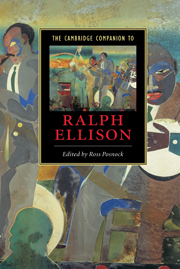Book contents
- Frontmatter
- Introduction
- 1 Ralph Ellison’s invented life
- 2 Ellison and the black Church
- 3 Ellison, photography, and the origins of invisibility
- 4 Ralph Ellison’s music lessons
- 5 Ralph Ellison’s constitutional faith
- 6 Ralph Ellison and the politics of melancholia
- 7 Invisible Ellison
- 8 Ellison’s experimental attitude and the technologies of illumination
- 9 Female iconography in Invisible Man
- 10 Chaos not quite controlled
- 11 Ralph Ellison, Hannah Arendt, and the meaning of politics
- 12 Dry bones
- Selected bibliography and suggestions for further reading
- Index
- Series List
2 - Ellison and the black Church
the gospel according to Ralph
Published online by Cambridge University Press: 28 May 2006
- Frontmatter
- Introduction
- 1 Ralph Ellison’s invented life
- 2 Ellison and the black Church
- 3 Ellison, photography, and the origins of invisibility
- 4 Ralph Ellison’s music lessons
- 5 Ralph Ellison’s constitutional faith
- 6 Ralph Ellison and the politics of melancholia
- 7 Invisible Ellison
- 8 Ellison’s experimental attitude and the technologies of illumination
- 9 Female iconography in Invisible Man
- 10 Chaos not quite controlled
- 11 Ralph Ellison, Hannah Arendt, and the meaning of politics
- 12 Dry bones
- Selected bibliography and suggestions for further reading
- Index
- Series List
Summary
''The point is, that like yourself, I existed in a field of influences . . . '' Three decades after a furious Ralph Ellison wrote this to his friend, the well-known critic Stanley Edgar Hyman in 1970, it's evident that this view has prevailed. Ellison's ''field of influences'' – which for Hyman consisted only of racial oppression and other African-American writers – is now furrowed with discussions of his debts not only to Richard Wright but also to Kenneth Burke, Hemingway, Dostoyevsky, and others. Yet one extraordinary influence remains overlooked: it is the debt Ellison owes what may loosely be called the ''black Church,'' and its role in the vision he at times fiercely opposed to that of Hyman and others. With the 1999 publication of Juneteenth this debt can no longer be ignored. Although Juneteenth is not, strictly speaking, Ellison's own second novel – he died in 1994, leaving it unfinished after forty years of effort – it is nevertheless his work, fashioned by his literary executor from Ellison's highly-polished narrative nuggets, some of which he published during his life. While we can't know how he would have assembled his own novel, its hero is clearly A. Z. Hickman, a Negro preacher who takes the Gospel as seriously as Ellison means readers to take Hickman himself. It is also clear that a pivotal chapter, both of Ellison's work-in-progress and Juneteenth, depicts Hickman's Christian conversion.
- Type
- Chapter
- Information
- The Cambridge Companion to Ralph Ellison , pp. 35 - 55Publisher: Cambridge University PressPrint publication year: 2005

